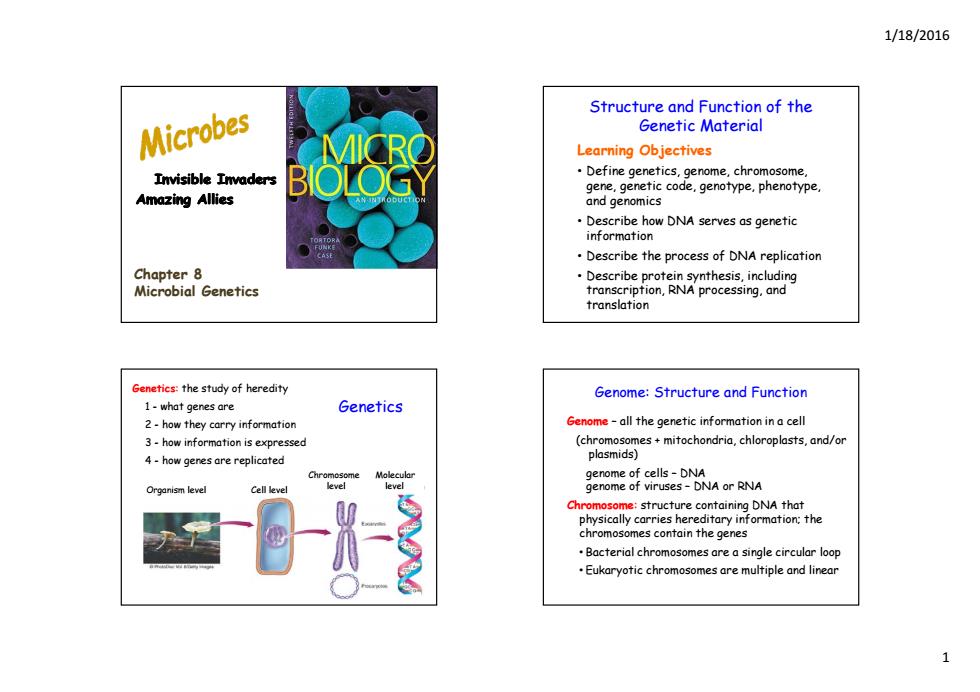
1/18/2016 Structure and Function of the Microbes Genetic Material Learning Objectives Invisible Invaders Define genetics,genome,chromosome, gene,genetic code,genotype,phenotype Amazing Allies and genomics Describe how DNA serves as genetic information ASE Describe the process of DNA replication Chapter 8 .Describe protein synthesis.including Microbial Genetics transcription,RNA processing.and translation Genetics:the study of heredity Genome:Structure and Function 1-what genes are Genetics 2-how they carry information Genome-all the genetic information in a cell 3-how information is expressed (chromosomes+mitochondria,chloroplasts,and/or 4-how genes are replicated plasmids) Chr Organism level Cell level Chromosome:structure containing DNA that physically carries hereditary information:the chromosomes contain the genes Bacterial chromosomes are a single circular loop Eukaryotic chromosomes are multiple and linear
1/18/2016 1 Invisible Invaders Amazing Allies Chapter 8 Microbial Genetics Learning Objectives Structure and Function of the Genetic Material • Define genetics, genome, chromosome, gene, genetic code, genotype, phenotype, and genomics • Describe how DNA serves as genetic information • Describe the process of DNA replication • Describe protein synthesis, including transcription, RNA processing, and translation Genetics Genetics: the study of heredity 1 - what genes are 2 - how they carry information 3 - how information is expressed 4 - how genes are replicated Chromosome Molecular level level Organism level Cell level Genome – all the genetic information in a cell (chromosomes + mitochondria, chloroplasts, and/or Genome: Structure and Function plasmids) genome of cells – DNA genome of viruses – DNA or RNA Chromosome: structure containing DNA that physically carries hereditary information; the chromosomes contain the genes • Bacterial chromosomes are a single circular loop • Eukaryotic chromosomes are multiple and linear
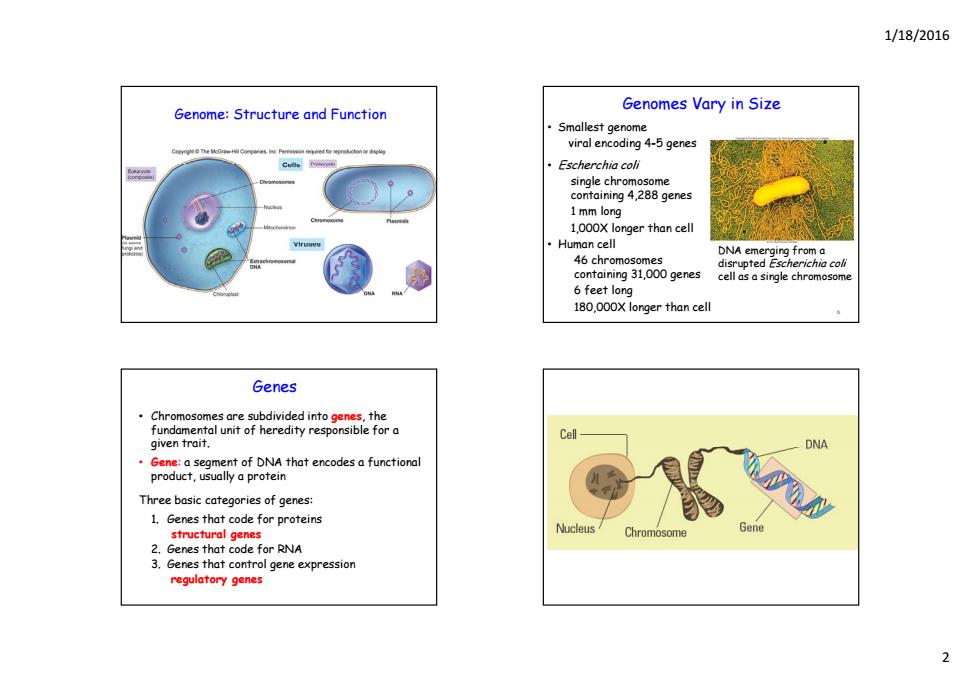
1/18/2016 Genomes Vary in Size Genome:Structure and Function ·Smallest genome viral encoding 4-5 genes Escherchia coli single chromosome containing 4,288 genes 1 mm long 1,000X longer than cell Human cell DNA emerging from a 46 chromo disrupted Escherichia coli containing 31,000 genes cell as a single chromosome 6 feet long 180,000X longer than cell Genes Chromosomes are subdivided into genes.the fundamental unit of heredity responsible for a Cell given trait. DNA Gene:a segment of DNA that encodes a functional product,usually a protein Three basic categories of genes: 1.Genes that code for proteins structural genes Nucleus Chromosome 2.Genes that code for RNA 3.Genes that control gene expression regulatory genes
1/18/2016 2 Genome: Structure and Function Genomes Vary in Size • Smallest genome viral encoding 4-5 genes • Escherchia coli single chromosome containing 4,288 genes 1 mm long 1,000X longer than cell • Human cell 6 46 chromosomes containing 31,000 genes 6 feet long 180,000X longer than cell DNA emerging from a disrupted Escherichia coli cell as a single chromosome • Chromosomes are subdivided into genes, the fundamental unit of heredity responsible for a given trait. Genes g ven tra t. • Gene: a segment of DNA that encodes a functional product, usually a protein Three basic categories of genes: 1. Genes that code for proteins structural genes 2. Genes that code for RNA 3. Genes that control gene expression regulatory genes
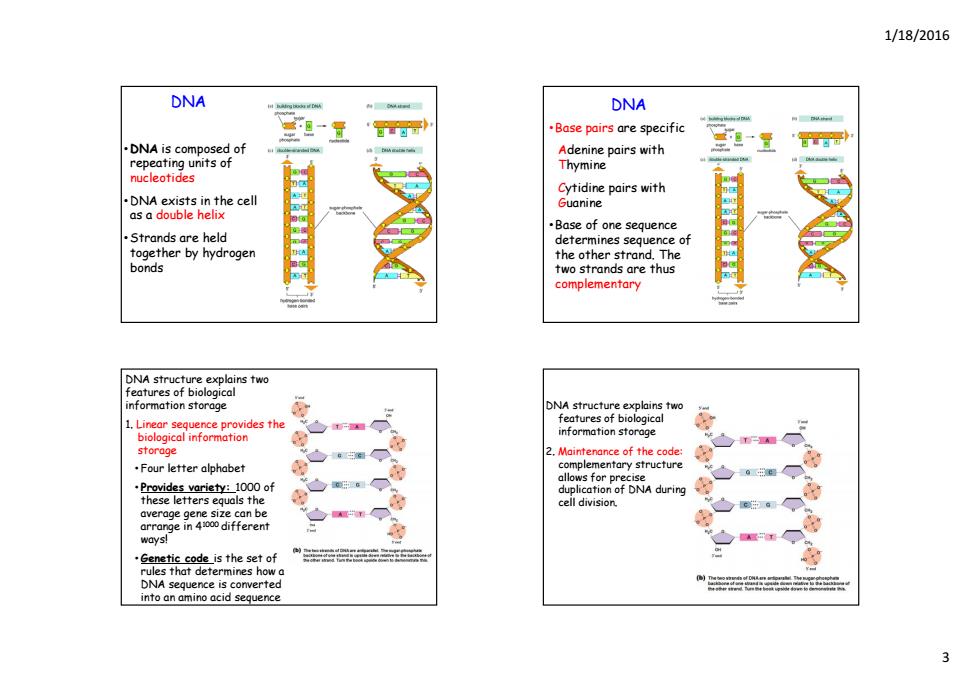
1/18/2016 DNA DNA 'a晋 .Base pairs are specific DNA is composed of Adenine pairs with repeating units of Thymine nucleotides Cytidine pairs with DNA exists in the cell Guanine as a double helix Base of one sequence Strands are held determines sequence of together by hydrogen the other strand.The bonds two strands are thus complementary explains two 9eahus6tb6Sgal information storage DNA structure explains two 1,Linear sequence provides the features of biological biological information information storage storage 2.Maintenance of the code: Four letter alphabet complementary structure allows for precise Provides variety:1000 of duplication of DNA during these letters equals the cell division. average gene size can be arrange in 41000 different ways! .Genetic code is the set of rules that determines how a DNA sequence is converted into an amino acid sequence 3
1/18/2016 3 • DNA is composed of repeating units of DNA nucleotides • DNA exists in the cell as a double helix •Strands are held together by hydrogen bonds • Base pairs are specific Adenine pairs with Thymine DNA Cytidine pairs with Guanine • Base of one sequence determines sequence of the other strand. The two strands are thus complementary DNA structure explains two features of biological information storage 1. Linear sequence provides the biological information storage • Four letter alphabet • Provides variety: 1000 of these letters equals the average gene size can be arrange in 41000 different ways! • Genetic code is the set of rules that determines how a DNA sequence is converted into an amino acid sequence DNA structure explains two features of biological information storage 2 . M i f h d Maintenance of the code: complementary structure allows for precise duplication of DNA during cell division

1/18/2016 Genotype and Phenotype Flow of Genetic Information All types of genes constitute the genetic makeup-genotype. Horizontal gene Vertical gene The expression of the genotype creates transter transfer observable traits-phenotype. DNA Replication:Preserving the Code and Overall Steps of DNA Replication Passing it On Each daughter molecule is identical to the parent in composition,but only one strand is completely The process of the genetic code duplicated new semiconservative replication and passed on to each offspring Requires 30 different enzymes Must be completed during a single generation fime Complementary structure provides a template for DNA replication
1/18/2016 4 Genotype and Phenotype All types of genes constitute the genetic makeup – genotype. The expression of the genotype creates observable traits – phenotype. Flow of Genetic Information Vertical gene t f Horizontal gene t f rans er transfer DNA Replication: Preserving the Code and Passing it On • The process of the genetic code duplicated and passed on to each offspring • Must be completed during a single generation time • Comp m ntary structur pro s a lementary structure provides a template for DNA replication Overall Steps of DNA Replication • Each daughter molecule is identical to the parent in composition, but only one strand is completely new semiconservative replication • Requires 30 different enzymes DNA Polymerase Helicase Template strands
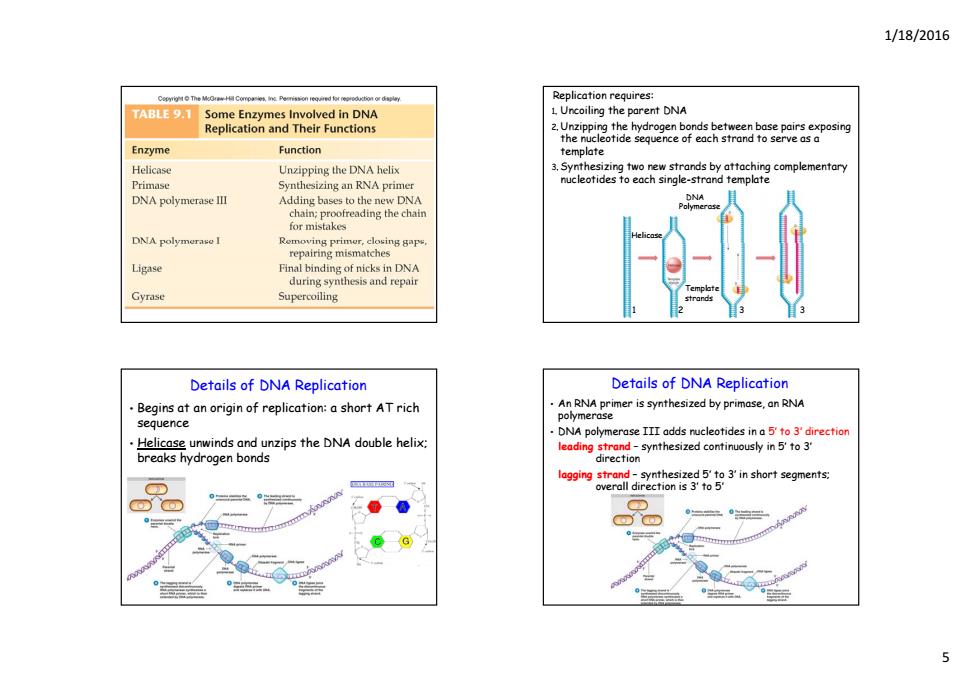
1/18/2016 Replication requires: Some Enzymes Involved in DNA 1 Uncoiling the parent DNA Replication and Their Functions 2.Unzipping the hydrogen bonds between base pairs exposing the nucleotide sequence of each strand to serve as a Enzyme Function template Helicase Unzipping the DNA helix 3.Synthesizing two new strands by attaching complementary Primase Synthesizing an RNA primer nucleotides to each single-strand template DNA polymerase IIl Adding bases to the new DNA chain;proofreading the chain for mistakes Ligase Final binding of nicks in DNA during synthesis and repair Gyrase Supercoiling Details of DNA Replication Details of DNA Replication Begins at an origin of replication:a short AT rich sequence DNA polymerase III adds nucleotides in a 5'to 3'direction Helicase unwinds and unzips the DNA double helix; leading strand-synthesized continuously in 5to 3 breaks hydrogen bonds direction ection is 3'to 5 G 5
1/18/2016 5 Replication requires: 1. Uncoiling the parent DNA 2. Unzipping the hydrogen bonds between base pairs exposing the nucleotide sequence of each strand to serve as a template 3. S nthesizin t ne str nds b tt chin Synthesizing two new strands by attaching c mplement r complementary nucleotides to each single-strand template DNA Polymerase Helicase Template strands 1 2 3 3 • Begins at an origin of replication: a short AT rich sequence • Helicase unwinds and unzips the DNA double helix; Details of DNA Replication p ; breaks hydrogen bonds • An RNA primer is synthesized by primase, an RNA polymerase • DNA polymerase III adds nucleotides in a 5′ to 3′ direction leading strand – synthesized continuously in 5′ to 3′ Details of DNA Replication leading strand synthesized continuously in 5 direction lagging strand – synthesized 5′ to 3′ in short segments; overall direction is 3′ to 5′
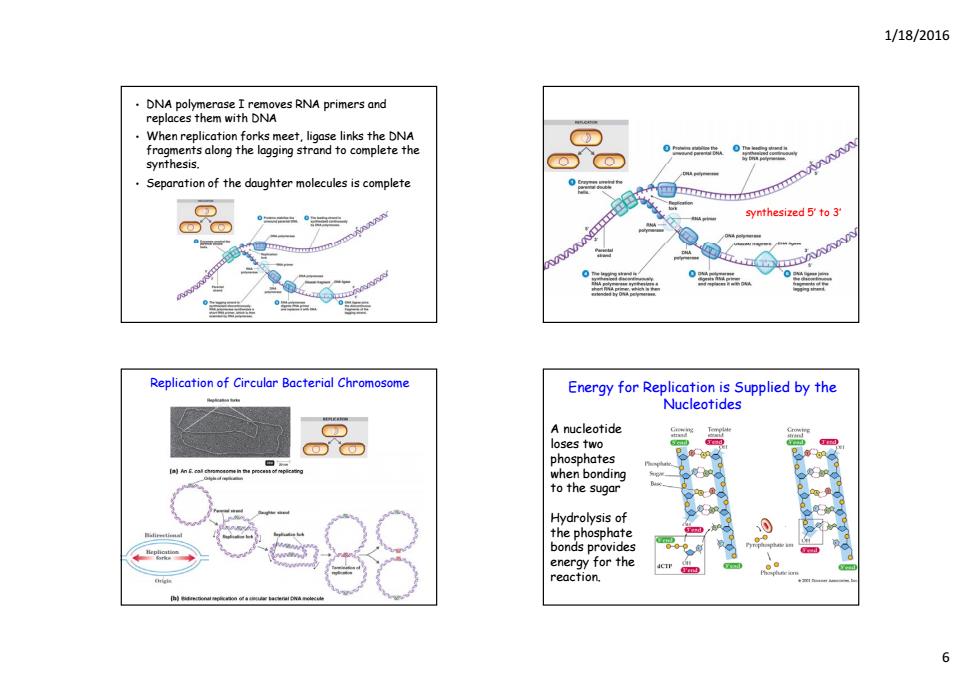
1/18/2016 DNA polymerase I removes RNA primers and replaces them with DNA When replication forks meet,ligase links the DNA fragments along the lagging strand to complete the 00 synthesis. Separation of the daughter molecules is complete synthesized 5'to 3 Replication of Circular Bacterial Chromosome Energy for Replication is Supplied by the Nucleotides A nucleotide loses two phosphates when bonding to the sugar Hydrolysis of the phosphate bonds provides eneray for the reaction h 6
1/18/2016 6 • DNA polymerase I removes RNA primers and replaces them with DNA • When replication forks meet, ligase links the DNA fragments along the lagging strand to complete the synthesis synthesis. • Separation of the daughter molecules is complete synthesized 5′ to 3′ Replication of Circular Bacterial Chromosome Energy for Replication is Supplied by the Nucleotides A nucleotide loses two phosphates when bonding to the sugar Hydrolysis of the phosphate bonds provides energy for the reaction
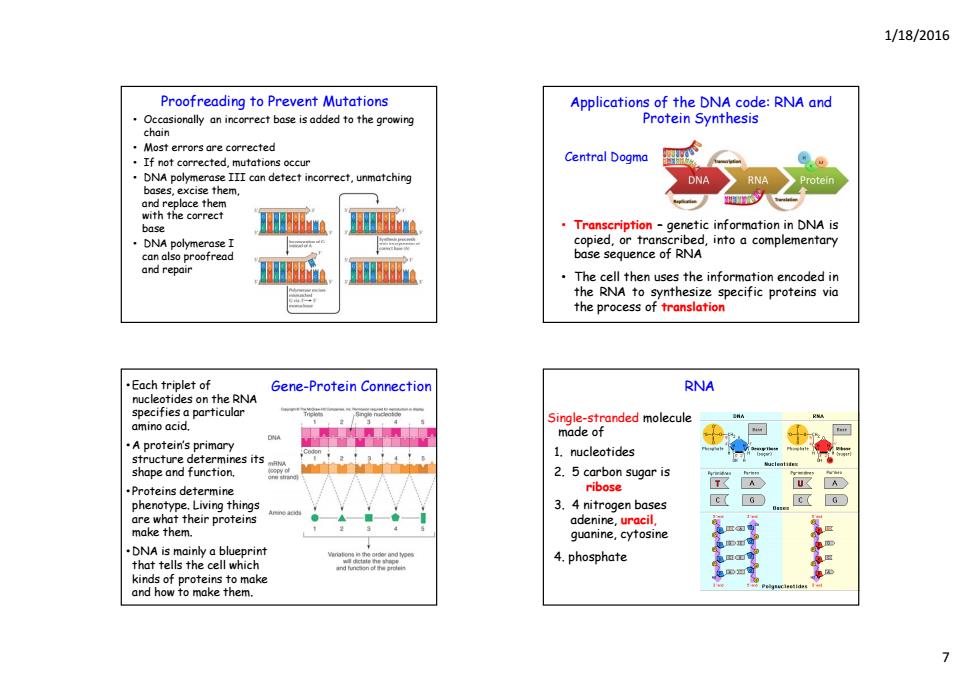
1/18/2016 Proofreading to Prevent Mutations Applications of the DNA code:RNA and Occasionally an incorrect base is added to the growing Protein Synthesis chain Most errors are corrected If not corrected.mutations occur Central Dogmo DNA polymerase III can detect incorrect,unmatching ONA RNA Protein bases,excise them, and replace them with the correct base Transcription genetic information in DNA is DNA polymerase can also proofread complementary and repair The cell then uses the information encoded in the RNA to synthesize specific proteins via the process of translation .Each triplet of Gene-Protein Connection RNA nucleotides on the RNA specifies a particular Single-stranded molecule amino acid. made of A protein's primary 1.nucleotides structure determines its shape and function. 2.5 carbon sugar is .Proteins determine ribose phenotype.Living things 3.4 nitrogen bases C(0 C(a are what their proteins adenine,uracil, make them. guanine,cytosine DNA is mainly a blueprint that tells the cell which 4.phosphate kinds of proteins to make and how to make them. >
1/18/2016 7 • Occasionally an incorrect base is added to the growing chain • Most errors are corrected • If not corrected mutations occur Proofreading to Prevent Mutations If not corrected, mutations occur • DNA polymerase III can detect incorrect, unmatching bases, excise them, and replace them with the correct base • DNA polymerase I can also proofread and repair Applications of the DNA code: RNA and Protein Synthesis Central Dogma • Transcription – genetic information in DNA is cop ed, i or transcr transcr bed, i into a complementary complementary base sequence of RNA • The cell then uses the information encoded in the RNA to synthesize specific proteins via the process of translation • Each triplet of Gene-Protein Connection nucleotides on the RNA specifies a particular amino acid. • A protein A protein s primary ’s primary structure determines its shape and function. • Proteins determine phenotype. Living things are what their proteins make them. • DNA is mainly a blueprint that tells the cell which kinds of proteins to make and how to make them. Single-stranded molecule made of 1 l id RNA . nucleotides 2. 5 carbon sugar is ribose 3. 4 nitrogen bases adenine, uracil, guanine, cytosine 4. phosphate

1/18/2016 3 Types of RNA 3 Types of RNA 1.Messenger RNA(mRNA) 2.Transfer RNA(tRNA) carries DNA coded message secondary structure (complementary copy)for making proteins creates loops message is in triplets called codons -bottom loop exposes a triplet of nucleotides C U G A U G A C U called the anticodon that 食息度息愈食息食愈 designates specificity and 866包8800 complements mRNA carries specific amino Codon 1 Codon2 Codon 3 acids to ribosomes P=Phosphate=Ribose U=Uracil a.IHNA-amino add 3 Types of RNA Transcription:The First Stage of Gene 3.Ribosomal RNA(rRNA) Expression component of ribosomes and participates in RNA polymerase binds to the promoter region protein synthesis providing peptidyl upstream of the gene transferase activity RNA polymerase adds RNA nucleotides complementary to the template strand of a segment of DNA in the 5'to 3'direction Suburits Uracil is placed as adenine's complement DNA 3'-ATGCAT would produce a 5'-UACGUA mRNA At termination,RNA polymerase recognizes signals in the sequence called the terminator and releases the transcript Short-term copies of the genes to be used to make proteins 305
1/18/2016 8 3 Types of RNA 1. Messenger RNA (mRNA) – carries DNA coded message ( mp m y py) f m g p complementary copy) for making proteins - message is in triplets called codons 3 Types of RNA 2. Transfer RNA (tRNA) - secondary structure creates loops - bottom loop exposes a triplet of nucleotides called the anticodon that designates specificity and complements mRNA - carries specific amino acids to ribosomes 3 Types of RNA 3. Ribosomal RNA (rRNA) - component of ribosomes and participates in protein synthesis providing peptidyl transferase activity Transcription: The First Stage of Gene Expression • RNA polymerase binds to the promoter region upstream of the gene • RNA polymerase adds RNA nucleotides complementary to the template strand of a segment of DNA in the 5′ to 3′ direction • Uracil is placed as adenine’s complement • DNA 3’-ATGCAT would produce a 5’-UACGUA mRNA • At termination, RNA polymerase recognizes signals in the sequence called the terminator and releases the transcript • Short-term copies of the genes to be used to make proteins
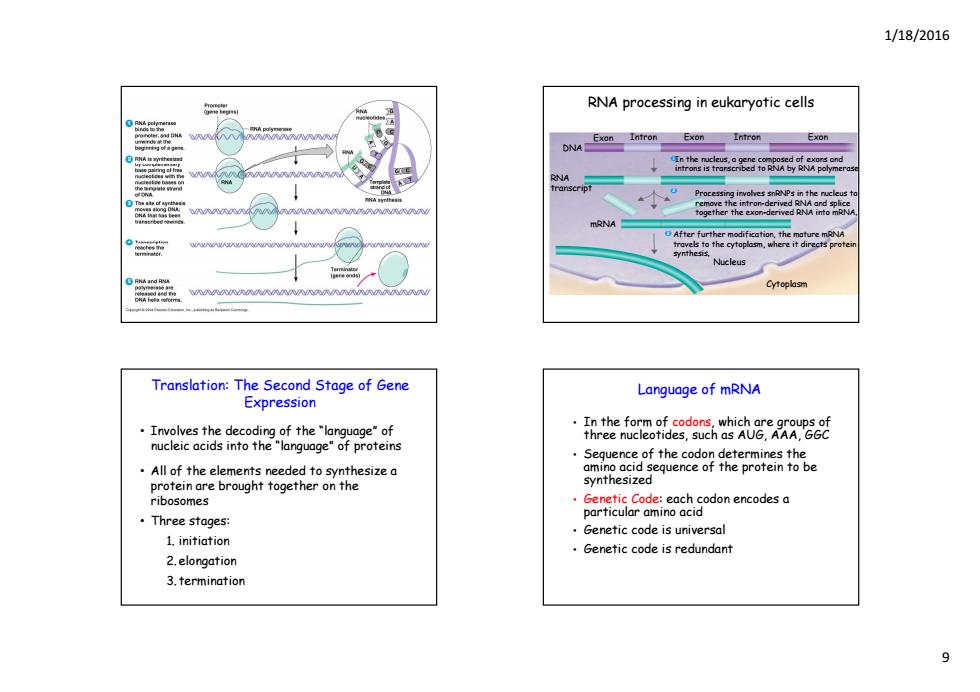
1/18/2016 RNA processing in eukaryotic cells Exon Intron Exon Intron Exon DNA RNA mRNA o After further modification,the mature mRNA Nucleus Cytoplasm Translation:The Second Stage of Gene Language of mRNA Expression Involves the decoding of the "language"of ·和emg0服n油地8X88 nucleic acids into the "language"of proteins Sequence of the codon determines the All of the elements needed to synthesize a amino acid sequence of the protein to be protein are brought together on the synthesized ribosomes Genetic Code:each codon encodesa ·Three stages particular amino acid Genetic code is universal 1.initiation Genetic code is redundant 2.elongation 3.termination 9
1/18/2016 9 RNA processing in eukaryotic cells RNA polymerase DNA Met Met Met DNA Exon Intron Exon Intron Exon 1In the nucleus, a gene composed of exons and Insert Fig 8.11 1 Met Met introns is transcribed to RNA by RNA polymerase RNA transcript mRNA 2 Processing involves snRNPs in the nucleus to remove the intron-derived RNA and splice together the exon-derived RNA into mRNA. 3 After further modification, the mature mRNA travels to the cytoplasm where it directs protein Nucleus Cytoplasm travels to the cytoplasm, where it directs protein synthesis. Translation: The Second Stage of Gene Expression • Involves the decoding of the “language” of nucleic acids into the nucleic acids into the language of proteins “language” of proteins • All of the elements needed to synthesize a protein are brought together on the ribosomes • Three stages: 1. initiation 2.elongation 3.termination Language of mRNA • In the form of codons, which are groups of three nucleotides, such as AUG, AAA, GGC • Sequence of the codon determines the amino acid sequence of the protein to be synthesized • Genetic Code: each codon encodes a particular amino acid • G ti ene c code i i l is universal • Genetic code is redundant
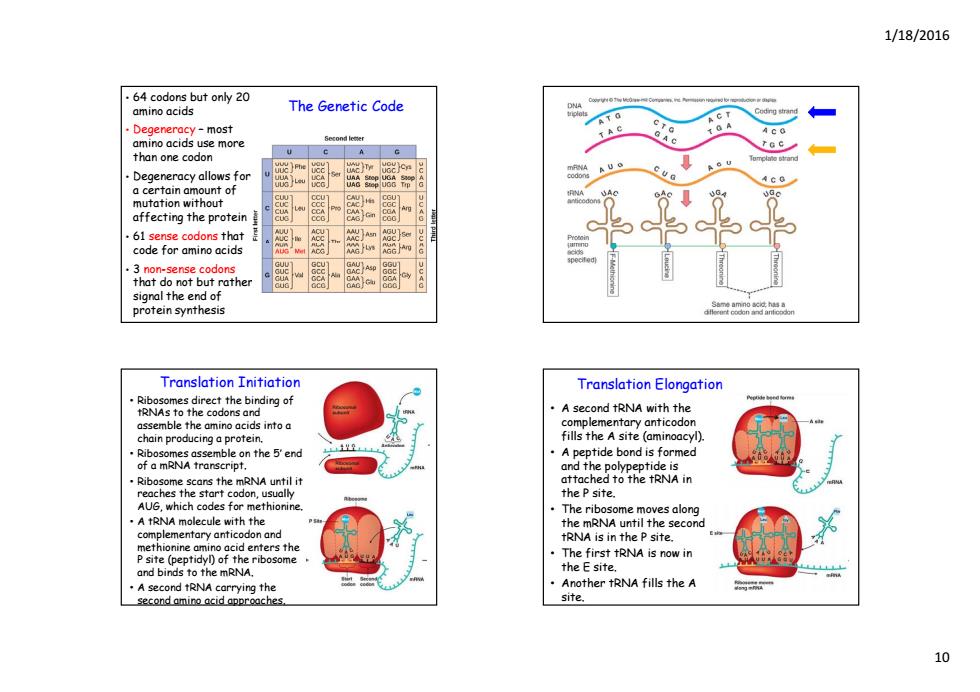
1/18/2016 64 codons but only 20 amino acids The Genetic Code AT G Degeneracy-most O A amino acids use more Second leeer than one codon Degeneracy allows for A U O a certain amount of mutation without affecting the protein 61 sense codons that code for amino acids 3 non-sense codons that do not but rather signal the end of protein synthesis Translation Initiation Translation Elongation Ribosomes direct the binding of tRNAs to the codons and ·A second tRNA with the assemble the amino acids into a complementary anticodon chain producing a protein. fills the A site (aminoacyl). Ribosomes assemble on the 5'end A peptide bond is formed of a mRNA transcript. and the polypeptide is mRNA until it attached to the tRNA in t codon,usually the P site. AUG,which codes for methionine. The ribosome moves along .A tRNA molecule with the the mRNA u anticodon and the second peiteerT0afqemtwwne tRNA is in the P site. ne am no ac id enters the The first tRNA is now in and binds to the mRNA. the E site. A second tRNA carrying the Another tRNA fills the A second amino acid approaches site
1/18/2016 10 The Genetic Code • 64 codons but only 20 amino acids • Degeneracy – most amino acids use more than one codon • Degeneracy allows for a certain amount of mutation without affecting the protein • 61 sense codons that code for amino acids • 3 non-sense codons that do not but rather signal the end of protein synthesis • Ribosomes direct the binding of tRNAs to the codons and assemble the amino acids into a chain producing a protein. Translation Initiation • Ribosomes assemble on the 5′ end of a mRNA transcript. • Ribosome scans the mRNA until it reaches the start codon, usually AUG, which codes for methionine. • A tRNA molecule with the complementary anticodon and methionine amino acid enters the P site (peptidyl) of the ribosome and binds to the mRNA. • A second tRNA carrying the second amino acid approaches. • A second tRNA with the complementary anticodon fills the A site (aminoacyl). id b d i f d Translation Elongation • A peptide bond is formed and the polypeptide is attached to the tRNA in the P site. • The ribosome moves along the mRNA until the second tRNA is in the P site. • The first tRNA is now in the E site. • Another tRNA fills the A site